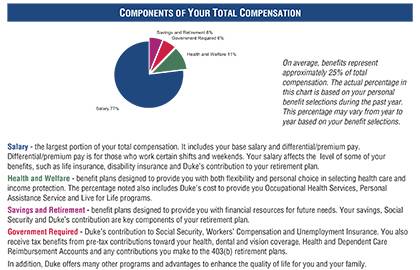Peek Inside Your Personalized Benefits Statement
Annual summary of total compensation being sent to employees

Beginning next week, faculty and staff will see how Duke's investment in them goes beyond just pay.
Duke Human Resources is mailing nearly 32,000 benefits eligible employees their Personal Benefit Statements, a breakdown of the total compensation Duke makes in each faculty and staff member through pay and benefits. The yearly summary highlights all the components of compensation, including salary, health and welfare, savings and retirement and Duke's contribution to government programs like Social Security.
"We offer a lot of different benefit programs and this statement offers a good summary of all the things employees have the opportunity to participate in," said Sylvester Hackney, associate director of Duke Benefits. "It's really important at least once a year to check-in on where you stand."
New on this year's Personal Benefit Statement is information about Duke's alternative transportation options, reflecting one of Duke's missions to highlight the importance of sustainable living.
Carbon emissions from employees who drive alone to work represent one of the largest hurdles to Duke's goal of climate neutrality by 2024. Currently, 71 percent of faculty and staff make solo commutes to work and transportation makes up 23 percent of Duke’s greenhouse gas emissions.
Using a home zip code, each statement now provides an estimate of what each statement recipient's carbon footprint is in relation to the mileage of their daily commute.
"To reduce Duke's transportation footprint and become carbon neutral by 2024, we rely on individuals to choose an alternative form of commuting," said Casey Roe, outreach coordinator for Sustainable Duke. "We hope that seeing the footprint of driving alone to work will encourage employees to try a sustainable commuting option."
Along with new information about carbon emissions, employees will find total compensation information related to their "traditional" benefits like health care, which represents the largest annual investment in employees by Duke.
Last year, Duke made an investment of $176 million to offer health care to faculty, staff and their dependents. For every dollar Duke puts into an employee's paycheck, it provides an average of 20 to 25 cents in other programs that benefit faculty, staff and their families. Last year, that represented an investment of more than $516 million, an increase of over $30 million from the previous year.
The Personal Benefits Statement also provides information about retirement planning, including a guide to determine whether or not an employee is on target to have enough savings when they retire.
For faculty and staff who want to learn more about how to best prepare for retirement, employees are invited to attend workshops or webcasts during Financial Fitness Week from May 12 to 15. For more information, visit the Financial Fitness Week website.
